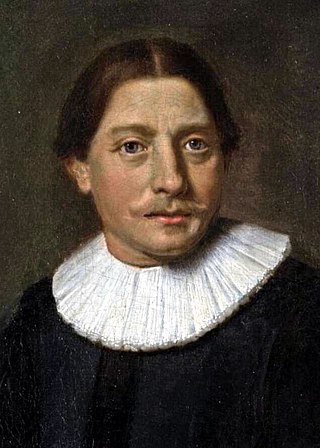| History of the Netherlands |
|---|
 |
To be included in this list, the place must have an article on Wikipedia or must have inline references showing the name is or was indeed Dutch.
| History of the Netherlands |
|---|
 |
To be included in this list, the place must have an article on Wikipedia or must have inline references showing the name is or was indeed Dutch.

Abel Janszoon Tasman was a Dutch seafarer and explorer, best known for his voyages of 1642 and 1644 in the service of the Dutch East India Company (VOC).

The Netherlands began its colonization of the Americas with the establishment of trading posts and plantations, which preceded the much wider known colonization activities of the Dutch in Asia. While the first Dutch fort in Asia was built in 1600 in present-day Indonesia, the first forts and settlements along the Essequibo River in Guyana date from the 1590s. Actual colonization, with the Dutch settling in the new lands, was not as common as by other European nations.

The maritime European exploration of Australia consisted of several waves of European seafarers who sailed the edges of the Australian continent. Dutch navigators were the first Europeans known to have explored and mapped the Australian coastline. The first documented encounter was that of Dutch navigator Willem Janszoon, in 1606. Dutch seafarers also visited the west and north coasts of the continent, as did French explorers.

Anthony van Diemen was a Dutch colonial governor.
The following are the regional bird lists by continent.

The Dutch colonial empire comprised the overseas territories and trading posts controlled and administered by Dutch chartered companies—mainly the Dutch East India Company and the Dutch West India Company—and subsequently by the Dutch Republic (1581–1795), and by the modern Kingdom of the Netherlands after 1815. It was initially a trade-based system which derived most of its influence from merchant enterprise and from Dutch control of international maritime shipping routes through strategically placed outposts, rather than from expansive territorial ventures. The Dutch were among the earliest empire-builders of Europe, following Spain and Portugal and one of the wealthiest nations of that time.

The Guianas, also spelled Guyanas or Guayanas, is a region in north-eastern South America. Strictly, the term refers to the three Guyanas: Guyana, Suriname and French Guiana, formerly British, Dutch and French Guyana. Broadly it refers to the South American coast from the mouth of the Oronoco to the mouth of the Amazon.
Ridderschap van Holland was a large retourschip, the largest class of merchantmen built by the Dutch East India Company to trade with the East Indies. In 1694 the ship sailed for Batavia on her fifth voyage, but was never heard from again. She is now thought to have been shipwrecked off the west coast of Australia.
Batavia may refer to:
Roman-Dutch law is an uncodified, scholarship-driven, and judge-made legal system based on Roman law as applied in the Netherlands in the 17th and 18th centuries. As such, it is a variety of the European continental civil law or ius commune. While Roman-Dutch law was superseded by Napoleonic codal law in the Netherlands proper as early as the beginning of the 19th century, the legal practices and principles of the Roman-Dutch system are still applied actively and passively by the courts in countries that were part of the Dutch colonial empire, or countries which are influenced by former Dutch colonies: Guyana, South Africa, Sri Lanka, Indonesia, Suriname, and the formerly Indonesian-occupied East Timor. It also heavily influenced Scots law. It also had some minor impact on the laws of the American state of New York, especially in introducing the office of Prosecutor (schout-fiscaal).

The Dutch diaspora consists of the Dutch and their descendants living outside the Netherlands.

The Dutch Empire is a term comprising different territories that were controlled by the Netherlands from the 17th to 20th centuries. They settled outside Europe with skills in trade and transport. In the late 16th century, the Netherlands reclaimed their lead at sea, and by the second half of the 17th century, dominated it. This hundred-year period is called the Dutch Golden Age. The Dutch built their empire with corporate colonialism by establishing the Dutch East India Company (VOC) and the Dutch West India Company (GWC), following Britain's footsteps, which led to war between both empires. After the French Revolutionary Wars, the Netherlands lost most of its power to the British after the French armies invaded the Netherlands and parts of the Dutch colonies. Hence, Dutch leaders had to defend their colonies and homeland. Between 1795 and 1814, the French restored the VOC in Indonesia and Suriname which remained under Dutch control.

Dutch colonial architecture refers to the various style of Dutch architecture built across the Dutch Empire. Though most of the buildings were designed by Dutch architects and dictated by Western architectural styles, even the most ardent style-purists among architects could not escape the forces of context and culture. Dutch colonial architecture often is a result of climatological adaptations or the use of local building materials - and more importantly, the rich and diverse cultural contexts. In this hybridity lies the quality of these buildings. Architecture shows that the strict racial taxonomy of a colonial system could not be maintained.
Long Island got its name in 1614 from Adriaen Block of Holland
Vansittart Bay was named after the Chancellor of Exchequer (Nicholas Vansittart, 1st Baron Bexley) by early explorer Phillip Parker King